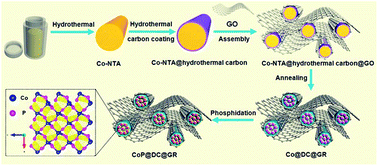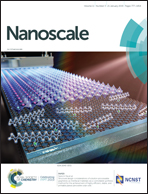A multidimensional and hierarchical carbon-confined cobalt phosphide nanocomposite as an advanced anode for lithium and sodium storage†
Abstract
Transition metal phosphides possess remarkable theoretical charge capacities; however, they demonstrate poor intrinsic electrical conductivity and enormous structure changes during cycling. Herein, a novel, multidimensional and hierarchical nanostructure is synthesized which constitutes 0D CoP nanoparticles distrbuted in a 1D dual carbon matrix and further homogenously encapsulated in a 3D graphene (GR) network; this material is denoted as CoP@DC@GR. This synergistic design produces superior advantages for lithium and sodium storage: (i) the ultrasmall and highly dispersed 0D CoP nanoparticles embedded in the 1D dual carbon matrix can decrease the electron/ion transport paths; (ii) the 3D interconnected architecture constructed from 2D GR and the 1D dual carbon matrix guarantees a robust structure to withstand the mechanical stress of the 1D dual carbon matrix, which can relieve volume inflation of the 0D CoP nanoparticles; (iii) the 1D dual carbon matrix and 3D GR frame structure offer continuous electron/ion transport routes, thus promoting rapid reaction kinetics. Due to this multiscale coordinated design, the CoP@DC@GR nanocomposite demonstrates high charge capacity, remarkable cycle stability, and distinguished rate performance; therefore, it possesses fascinating potential in anodes for lithium and sodium storage.



 Please wait while we load your content...
Please wait while we load your content...